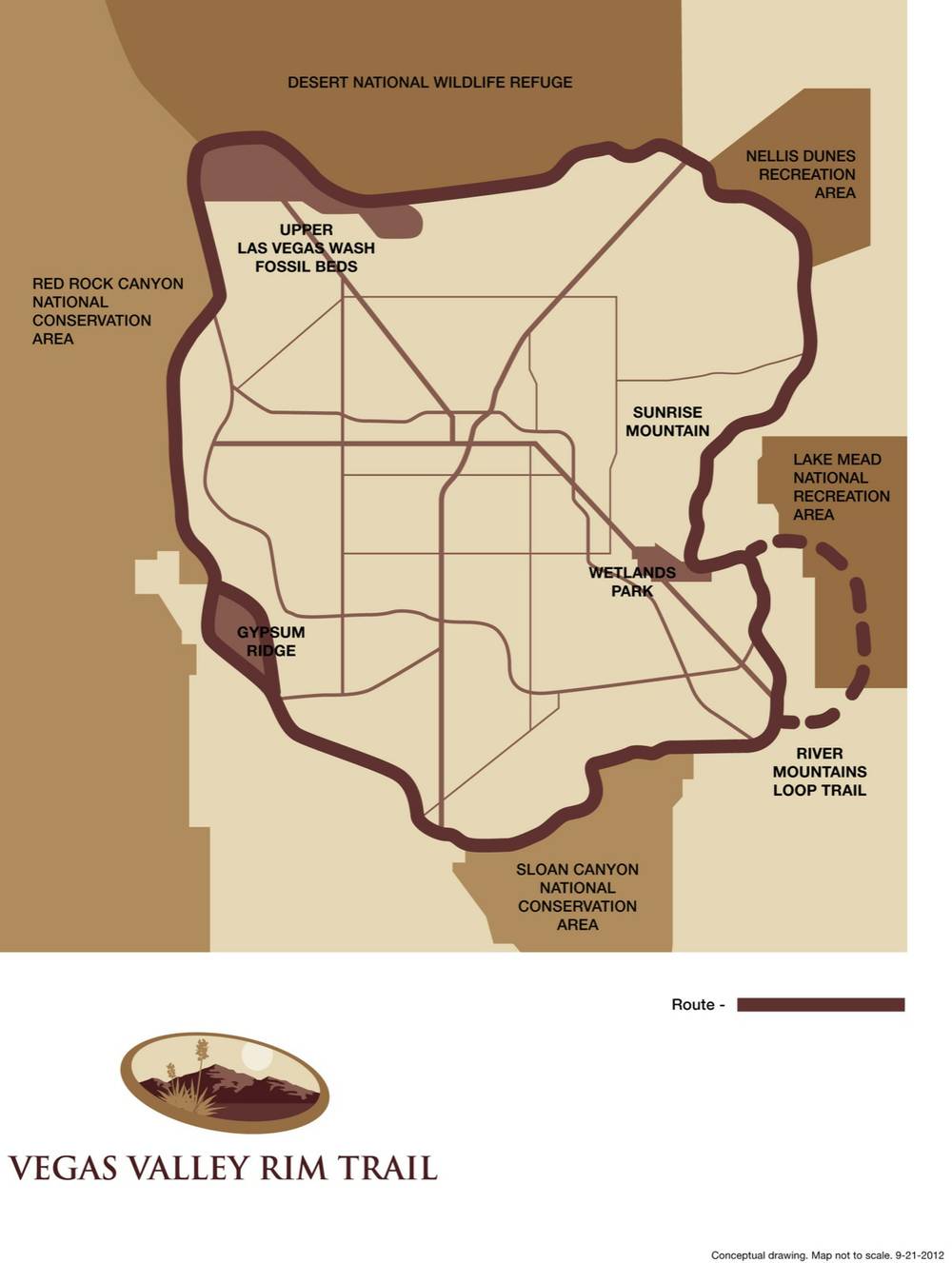The Outdoor Issue
- The beautiful, technical, secret worlds of canyoneering
- The hunger of a man denied: Will Swope eyes the Spartan Race podium
- Air Force S.E.R.E. Specialists are masters in the art of survival
- Fireside fare: Chef Charlie Palmer has your recipe for stellar camp cuisine
- Inside the photos of adventure junkie Cameron Grant
- Gear to outfit your dog with for your next hiking adventure
- Hit the trail: Our guide to 10 of the Las Vegas Valley’s best routes
- Gear up: 5 essentials (and sexy upgrades) for the great outdoors
- A city girl in hot water: Exploring some nearby hot springs
- Fun runs that are actually fun
Driving down the 95 or the 215, you get a feel for the curves of the Valley, the giant circle running around the outside of our nonstop urban shuffle. Running or biking or riding a horse on the paths that follow a similar line, you become part of the vision of the Vegas Valley Rim Trail.
In the works since an open-space study introduced the idea in 2007, the Rim Trail remains a vision because its 100-plus miles encircling the Valley are still being dreamed up, funded and built. There are gaps between existing sections, now part of a master plan adopted by the cities of Las Vegas, North Las Vegas and Henderson as well as Clark County and supported by agencies ranging from the National Parks Service and the BLM to the Southern Nevada Regional Planning Coalition and Regional Transportation Commission. Many jurisdictions have been involved in discussion and execution of the monster trail pieced together with smaller ones, and though it likely won’t be completed until at least 2020, their cooperation busts myths about committees not getting things done.
Because the nonprofit Outside Las Vegas Foundation was already part of the Regional Open Space and Trails Workgroup and facilitating different jurisdictions coming together on the subject of local trails, it was asked to wrangle the massive Vegas Valley Rim Trail project. “The big focus at that time, in 2010, was to really just keep this idea alive and keep the jurisdictions focused on it,” says Mauricia M.M. Baca, executive director of OLVF.
While the Great Circle and Valle Verde were considered as names for the network, Vegas Valley Rim Trail won out. When the project passed to OLVF, Baca says it was a binder full of “30,000-foot ideas.”
“It was a really thick line going around the Valley where the trail might be,” Baca says of the lofty original map. OLVF Associate Director Rae Lathrop chimes in that the line was about a mile wide if you manifested it to scale. “We avoided using that map too literally,” Baca says, laughing.
OLVF reached out to planners on the ground, so to speak, the ones who understood what was realistic. They assessed challenges in the near and distant future. They considered the needs of a spectrum of users and how to satisfy them. Baca says that from the start, the work of city, county and federal planners has been a marvel of cooperation.
“Not enough gets said about how these dedicated professionals work well together and are willing to work with us as a nonprofit organization to make this happen,” she says.
In addition to creating plans for new trails that will fill in the gaps, they’re working on finding public funds and looking ahead so that connections of different sections in different parts of the Valley are natural and efficient. They want a balance of paved and rugged, and robust amenities to serve the diverse community of locals who love to get outside. When every mile of the paved trails with lots of bells and whistles can cost half a million to a million dollars, there has to be serious forethought.
“It has been their intention now, working for the last couple of years, to figure out how to connect different segments so that the Valley itself is more networked,” Lathrop says of the disparate jurisdictions’ gradual transition from focusing on their own objectives to working toward a cohesive, collective goal of multi-modal transit and recreation benefiting the entire Valley. She adds that OLVF just finished combining all of the GIS (Geographic Information System) data into one map to show exactly how much has been accomplished and all that is hoped for the future.
“We’ve actually had an incredible amount of progress,” Baca says.
One example is the Las Vegas Wash Trail. It didn’t exist when the Vegas Valley Rim Trail project launched, and today it comprises 35 miles of paved paths (mostly uninterrupted by street crossings) taking users from North Las Vegas all the way to the Wetlands Park in Henderson. Among others, the River Mountains Loop through the Lake Mead area and Boulder City and the McCullough Hills Trail stretching from Henderson to Anthem are part of the Vegas Valley Rim Trail’s dashed line, and Baca says OLVF is looking at taking it into more wild areas and even a proposed national monument site.
The scope of the project comes down to time and money, whether from the Southern Nevada Public Land Management Act or the Land and Water Conservation Fund, federal grants or donations from individuals who want to be part of creating and caring for the trails that make up the Vegas Valley Rim Trail.
“The Tahoe Rim Trail took something like 20 years,” Baca says. “If in 2024 we’re completely done with this trail I’ll be really excited. If it’s by 2020, that will be wonderful.”
With the jurisdictions already engaged, OLVF is working on a core group of residents to become trail stewards. That means enjoying the trails while looking for any issues that need attention and reporting them to the right officials. OLVF’s Eric Larsen, who directs the Get Outdoors Nevada program, says such vigilant volunteers make maintenance faster and less expensive as cities don’t have to send employees to check conditions. He hopes to develop a large body of volunteers and “a greater sense of ownership.” Baca adds that there are several user groups, from runners to horseback riders, who’ve been great with feedback, but the Vegas Valley Rim Trail can only get stronger with more voices behind it.
“As this project is developing, it’s very important that people go outside and feel good about it and then become those constituents that really care for the Vegas Valley Rim Trail when it’s finally done,” Lathrop says. “We’re planning and building it at the same time that we’re trying to teach people how to take care of it, how to use it, so that when it’s all done we have this one great community of people that really love it.”
For those who want to get involved before the ribbon is cut (and Larsen goes for a victory scooter ride all the way around), there are opportunities to pitch in on beautification, invasive species removal and even supporting athletic events on trails. Just visit Get Outdoors Nevada. And to keep up with the adventure of the Vegas Valley Rim Trail, visit its Facebook page.
Larsen says: “We’re still a relatively young community, so there’s a lot of growth still taking place, which means we have a lot of great things to do.”








